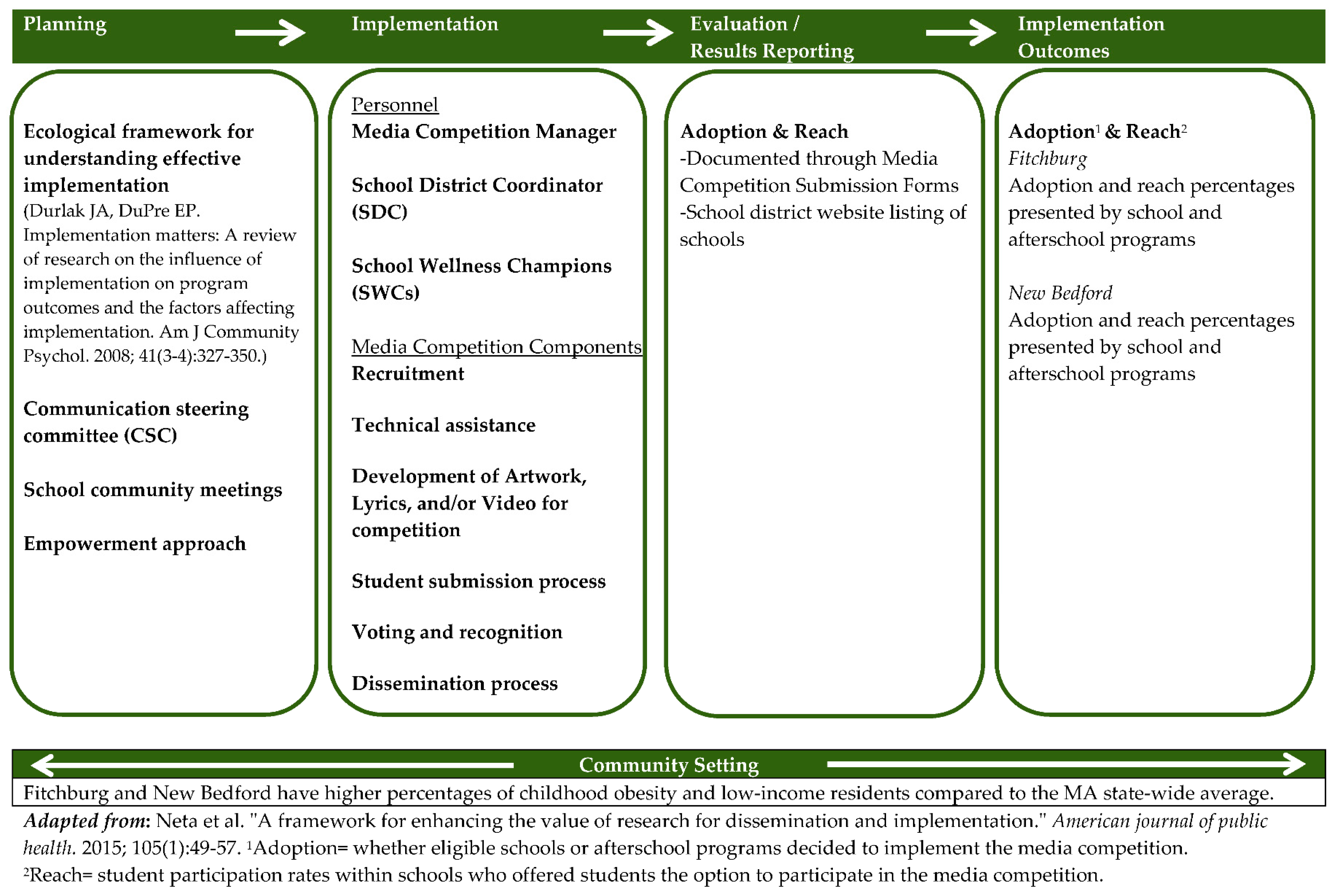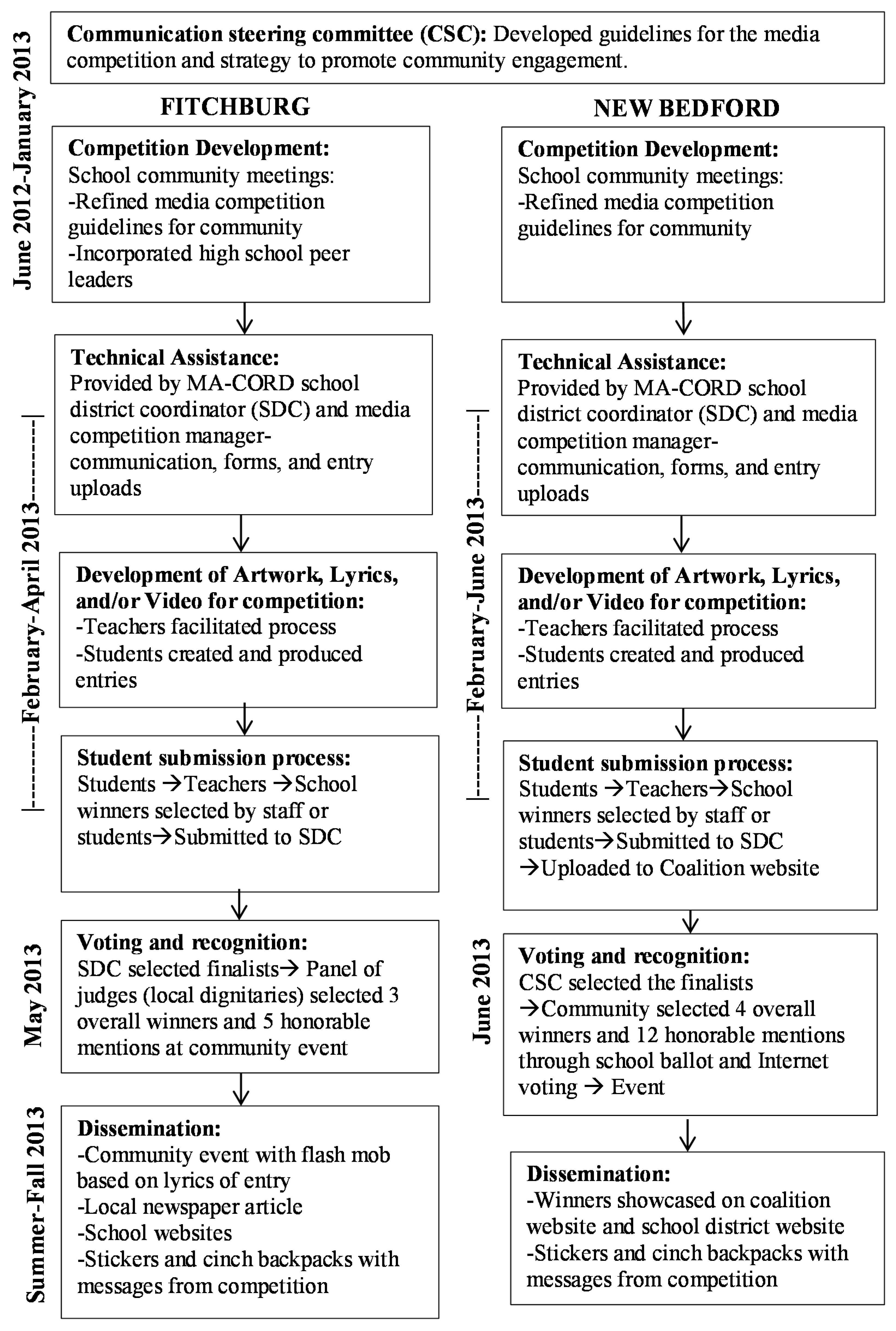Media Competition Implementation for the Massachusetts Childhood Obesity Research Demonstration Study (MA-CORD): Adoption and Reach
Abstract
:1. Introduction
MA-CORD Overview
2. Methods
2.1. Empowerment Approach
2.2. Theoretical Framework
2.3. Community Setting
2.4. Implementation
2.4.1. Communication Steering Committee (CSC)
2.4.2. School Community Meetings
2.4.3. Technical Assistance
2.4.4. Guidelines
2.4.5. Voting
2.4.6. Recognition
2.5. Participants
2.6. Measures: Reach and Adoption
2.7. Data Collection and Analysis
3. Results
3.1. Participation Levels
3.2. Adoption
3.3. Reach
4. Discussion
Strengths and Limitations
5. Conclusions
Acknowledgments
Author Contributions
Conflicts of Interest
References
- National Center for Health Statistics. NCHS Data on Obesity, 2012. Available online: http://www.cdc.gov/nchs/data/factsheets/factsheet_obesity.htmnhanes/growthcharts/clinical_charts.htm (accessed on 9 September 2013).
- U.S. Department of Health and Human Services. The Surgeon General’s Call to Action to Prevent and Decrease Overweight and Obesity; U.S. Department of Health and Human Services, Public Health Service, Office of the Surgeon General: Rockville, MD, USA, 2001. [Google Scholar]
- Skelton, J.A.; Irby, M.B.; Grzywacz, J.G.; Miller, G. Etiologies of obesity in children: Nature and nurture. Pediatr. Clin. North Am. 2011, 58, 1333–1354. [Google Scholar] [CrossRef] [PubMed]
- Economos, C.D.; Hyatt, R.R.; Must, A.; Goldberg, J.P.; Kuder, J.; Naumova, E.N.; Collins, J.J.; Nelson, M.E. Shape up Somerville two-year results: A community-based environmental change intervention sustains weight reduction in children. Prev. Med. 2013, 57, 322–327. [Google Scholar] [CrossRef] [PubMed]
- De Silva-Sanigorski, A.M.; Bell, A.C.; Kremer, P.; Nichols, M.; Crellin, M.; Smith, M.; Sharp, S.; de Groot, F.; Carpenter, L.; Boak, R. Reducing obesity in early childhood: Results from Romp & Chomp, an Australian community-wide intervention program. Am. J. Clin. Nutr. 2010, 91, 831–840. [Google Scholar] [PubMed]
- Glasgow, R.E.; Emmons, K.M. How can we increase translation of research into practice? Types of evidence needed. Annu. Rev. Public Health 2007, 28, 413–433. [Google Scholar] [CrossRef] [PubMed]
- Mercer, S.L.; DeVinney, B.J.; Fine, L.J.; Green, L.W.; Dougherty, D. Study designs for effectiveness and translation research: Identifying trade-offs. Am. J. Prev. Med. 2007, 33, 139–154. [Google Scholar] [CrossRef] [PubMed]
- Green, L.W.; Ottoson, J.; García, C.; Robert, H. Diffusion theory and knowledge dissemination, utilization, and integration in public health. Annu. Rev. Public Health 2009, 30, 151. [Google Scholar] [CrossRef] [PubMed]
- Wagner, E.H. Chronic disease management: What will it take to improve care for chronic illness? Eff. Clin. Pract. ECP. 1997, 1, 2–4. [Google Scholar]
- Taveras, E.M.; Blaine, R.E.; Davison, K.K.; Gortmaker, S.; Anand, S.; Falbe, J.; Kwass, J.-A.; Perkins, M.; Giles, C.; Criss, S.; et al. Design of the Massachusetts Childhood Obesity Research Demonstration (MA-CORD) Study. Child. Obes. 2015, 11, 11–22. [Google Scholar] [PubMed]
- Davison, K.K.; Falbe, J.; Taveras, E.M.; Gortmaker, S.; Kulldorff, M.; Perkins, M.; Blaine, R.E.; Franckle, R.L.; Ganter, C.; Woo Baidal, J. Evaluation Overview for the Massachusetts Childhood Obesity Research Demonstration (MA-CORD) Project. Child. Obes. 2015, 11, 23–36. [Google Scholar] [PubMed]
- Dooyema, C.A.; Belay, B.; Foltz, J.L.; Williams, N.; Blanck, H.M. The childhood obesity research demonstration project: A comprehensive community approach to reduce childhood obesity. Child. Obes. 2013, 9, 454–459. [Google Scholar] [PubMed]
- Goldberg, J.P.; Folta, S.C.; Eliasziw, M.; Koch-Weser, S.; Economos, C.D.; Hubbard, K.L.; Peterson, L.A.; Wright, C.M.; Must, A. Great Taste, Less Waste: A cluster-randomized trial using a communications campaign to improve the quality of foods brought from home to school by elementary school children. Prev. Med. 2015, 74, 103–110. [Google Scholar] [CrossRef] [PubMed]
- Buliung, R.; Faulkner, G.; Beesley, T.; Kennedy, J. School travel planning: mobilizing school and community resources to encourage active school transportation. J. Sch. Health 2011, 81, 704–712. [Google Scholar] [CrossRef] [PubMed]
- Wong, N.; Zimmerman, M.; Parker, E. A Typology of Youth Participation and Empowerment for Child and Adolescent Health Promotion. Am. J. Community Psychol. 2010, 46, 100–114. [Google Scholar] [CrossRef] [PubMed]
- Jennings, L.B.; Parra-Medina, D.M.; Hilfinger-Messias, D.K.; McLoughlin, K. Toward a critical social theory of youth empowerment. J. Community Pract. 2006, 14, 31–55. [Google Scholar] [CrossRef]
- Neta, G.; Glasgow, R.E.; Carpenter, C.R.; Grimshaw, J.M.; Rabin, B.A.; Fernandez, M.E.; Brownson, R.C. A framework for enhancing the value of research for dissemination and implementation. Am. J. Public Health 2015, 105, 49–57. [Google Scholar] [CrossRef] [PubMed]
- Rogers, E.M. Diffusion of Innovations; Simon and Schuster: New York, NY, USA, 2010. [Google Scholar]
- Durlak, J.A.; DuPre, E.P. Implementation matters: A review of research on the influence of implementation on program outcomes and the factors affecting implementation. Am. J. Community Psychol. 2008, 41, 327–350. [Google Scholar] [CrossRef] [PubMed]
- Featherston, K.A. School Adoption and Utilization of NFL PLAY 60 Programming. Res. Q. Exerc. Sport 2014, 85, A4. [Google Scholar]
- Fuel Up to Play 60. Touchdown Dance Challenge Flyer, 2012. Available online: http://utahnevadadairycouncil.fueluptoplay60.com/wp-content/uploads/2012/06/Touchdown-Challenge-Flyer.pdf (accessed on 28 August 2015).
- Fuel Up to NFL Play 60. Empowering Youth, Schools and Communities to Implement Healthy Changes across the Nation 2015. Available online: https://www.fueluptoplay60.com/?classic=1 (accessed on 28 August 2015).
- Brown, T.; Summerbell, C. Systematic review of school-based interventions that focus on changing dietary intake and physical activity levels to prevent childhood obesity: An update to the obesity guidance produced by the National Institute for Health and Clinical Excellence. Obes. Rev. 2009, 10, 110–141. [Google Scholar] [CrossRef] [PubMed]
- Sharma, M. School-based interventions for childhood and adolescent obesity. Obes. Rev. 2006, 7, 261–269. [Google Scholar] [CrossRef] [PubMed]
- Zenzen, W.; Kridli, S. Integrative review of school-based childhood obesity prevention programs. J. Pediatr. Health Care 2009, 23, 242–258. [Google Scholar] [CrossRef] [PubMed]
- Branscum, P.; Sharma, M. After-school based obesity prevention interventions: A comprehensive review of the literature. Int. J. Environ. Res. Public Health 2012, 9, 1438–1457. [Google Scholar] [CrossRef] [PubMed]
- Carroll, C.; Patterson, M.; Wood, S.; Booth, A.; Rick, J.; Balain, S. A conceptual framework for implementation fidelity. Implement. Sci. 2007, 2, 40. [Google Scholar] [CrossRef] [PubMed]


| Socio-Demographic Characteristics | Massachusetts | Fitchburg | New Bedford |
|---|---|---|---|
| Total population 1 | 6,436,940 | 40,514 | 94,502 |
| % White (any race) 1 | 76.1 | 68.2 | 67.9 |
| % Black or African American (any race) 1 | 6.0 | 1.1 | 5.2 |
| % Hispanic or Latino (any race) 1 | 9.6 | 21.6 | 16.7 |
| % of children overweight or obese 2009–2010 2 | 33.4 | 46.2 | 37.2 |
| Average per capita income 3 | $35,485 | $22,949 | $21,343 |
| % Families with children whose incomes are less 100% or more of the Federal Poverty Level 3 | 12.0 | 23.5 | 27.1 |
| # of public schools serving students kindergarten through 8th grade 2012–2013 4 | ~1500 | 6 | 23 |
| School Type | Participation | Reach (Student Participation) Level | Grade Level | |
|---|---|---|---|---|
| # of Students | Reach (% Student Participation) | |||
| Fitchburg | ||||
| Elementary School * | 40 | 6% | Moderate | 2nd–4th |
| Elementary School * | 192 | 30% | High | 3rd–4th |
| Elementary School * | 25 | 4% | Moderate | 4th |
| Middle School * | 25 | 4% | Moderate | 5th–7th |
| Middle School * | 50 | 8% | Moderate | 5th–7th |
| Middle School (MI) | 30 | 6% | Moderate | 5th–6th, 8th |
| Middle Afterschool * | 15 | 33% | Moderate | 5th–7th |
| Community Total: | 377 | 10% (schools) 33% (afterschool) | ||
| New Bedford | ||||
| Elementary School * | 38 | 5% | Moderate | 4th–5th |
| Elementary School (NI) | 23 | 4% | Moderate | 3rd–5th |
| Elementary School * | 120 | 13% | High | 4th |
| Elementary School (NI) | 3 | <1% | Low | 3rd |
| Elementary School * | 11 | <1% | Low | 5th |
| Elementary School (NI) | 2 | <1% | Low | 5th |
| Elementary School (MI) | 10 | 3% | Low | 5th |
| Elementary School (MI) | 2 | <1% | Low | 5th |
| Middle School (NI) | 1 | <1% | Low | Not specified |
| Elementary Afterschool (MI) | 3 | 1% | Low | 2nd–3rd |
| Elementary Afterschool (NI) | 5 | 16% | Moderate | 5th |
| Community Total: | 218 | 3% (schools) + 9% (afterschool) | ||
| Intervention Total: | 595 | |||
© 2016 by the authors; licensee MDPI, Basel, Switzerland. This article is an open access article distributed under the terms and conditions of the Creative Commons by Attribution (CC-BY) license (http://creativecommons.org/licenses/by/4.0/).
Share and Cite
Criss, S.; Cheung, L.; Giles, C.; Gortmaker, S.; Viswanath, K.; Kwass, J.-A.; Davison, K. Media Competition Implementation for the Massachusetts Childhood Obesity Research Demonstration Study (MA-CORD): Adoption and Reach. Int. J. Environ. Res. Public Health 2016, 13, 403. https://doi.org/10.3390/ijerph13040403
Criss S, Cheung L, Giles C, Gortmaker S, Viswanath K, Kwass J-A, Davison K. Media Competition Implementation for the Massachusetts Childhood Obesity Research Demonstration Study (MA-CORD): Adoption and Reach. International Journal of Environmental Research and Public Health. 2016; 13(4):403. https://doi.org/10.3390/ijerph13040403
Chicago/Turabian StyleCriss, Shaniece, Lilian Cheung, Catherine Giles, Steven Gortmaker, Kasisomayajula Viswanath, Jo-Ann Kwass, and Kirsten Davison. 2016. "Media Competition Implementation for the Massachusetts Childhood Obesity Research Demonstration Study (MA-CORD): Adoption and Reach" International Journal of Environmental Research and Public Health 13, no. 4: 403. https://doi.org/10.3390/ijerph13040403





